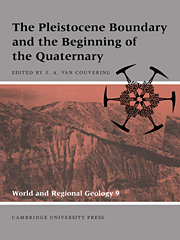Book contents
- Frontmatter
- Contents
- List of contributors
- Preface: the new Pleistocene
- Foreword
- Part I Definition of the base of the Quaternary
- Part II Characterization of the Pleistocene boundary-stratotype
- Part III The paleontological context of the Pleistocene boundary
- Part IV The Pleistocene boundary in regional sequences
- Index
Preface: the new Pleistocene
Published online by Cambridge University Press: 10 November 2009
- Frontmatter
- Contents
- List of contributors
- Preface: the new Pleistocene
- Foreword
- Part I Definition of the base of the Quaternary
- Part II Characterization of the Pleistocene boundary-stratotype
- Part III The paleontological context of the Pleistocene boundary
- Part IV The Pleistocene boundary in regional sequences
- Index
Summary
Nailing down the golden spike
The goal of the International Geological Correlation Program, Project 41 (IGCP-41), was to propose a formal definition for the base of the Pleistocene Series – by international agreement the lower (and only) boundary of the Quaternary subsystem – in accordance with the resolution passed by the XVIII International Geological Congress (IGC) in London in 1948 (King and Oakley, 1950), as well as to characterize and globally correlate this boundary. After years of study and discussion, as described by K. V. Nikiforova and M. N. Alekseev in the first chapter of this volume, the members of IGCP-41 agreed on a boundary defined by a physical reference point or “golden spike” within the outer-shelf marine section exposed at Vrica, near Crotone, Calabria. As this book demonstrates, the members of IGCP-41 were able to recognize this level in marine and nonmarine sections around the world. The Vrica boundary-stratotype for the Pleistocene boundary was ratified and adopted by the international authorities and has gained approval as a global boundary-stratotype section and point (GSSP) (Cowie and Bassett, 1989).
The participants in IGCP-41 may take pride in the establishment, at long last, of an internationally accepted and unambiguous definition for the base of the Pleistocene. With regard to this momentous advance, this book has three aims: (1) to document the Vrica boundary-stratotype; (2) to show how the boundary-stratotype can be characterized in terms of the paleontological and paleoenvironmental record, radiometric dating and magnetostratigraphy; and (3) to describe the worldwide stratigraphic context of the boundary.
- Type
- Chapter
- Information
- The Pleistocene Boundary and the Beginning of the Quaternary , pp. xi - xviiiPublisher: Cambridge University PressPrint publication year: 1996
- 3
- Cited by



